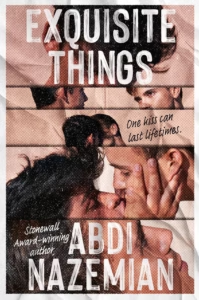Exquisite Things
Abdi Nazemian
HarperCollins
Published September 23, 2025
Amazon | Bookshop | Goodreads
About Exquisite Things
From Stonewall Award–winning author Abdi Nazemian (Only This Beautiful Moment) comes the epic queer love story of a lifetime. Perfect for fans of The Invisible Life of Addie LaRue and The Picture of Dorian Gray.
Shahriar believes he was born in the wrong time. All he’s ever wanted is to love and be loved, but 1895 London doesn’t offer him the freedom to be his true self, and Oscar Wilde’s trial for gross indecency has only reaffirmed that. But one night—and one writer—will grant Shahriar what he’s always wished for: the opportunity to live in a time and place where he can love freely. Rechristened as Shams and then as Bram, he finds what feels like eternal happiness. But can anything truly be eternal?
Oliver doesn’t feel that 1920s Boston gives him a lot of options to be his full self. He knows he could only ever love another boy, but that would break his beloved mother’s heart. Oliver finds freedom and acceptance in the secret queer community at Harvard that his cousin introduces him to. When he meets a mysterious boy with eyes as warm as a flame, his life is irrevocably changed, forever.
Spanning one hundred and thirty years of love and longing, this tale of immortal beloveds searching for their perfect place and time is a vibrant hymn to the beauty of being alive, a celebration of queer love and community, and a reminder that behind every tragic thing that ever existed, there is something exquisite.
My Review
I recently read Only This Beautiful Moment, so this wasn’t my first rodeo with Nazemian and storytelling spanning decades. One thing I have to say is that I didn’t have a hard time following the narrative through the different moments in time. Scenes take place in 1895, 1920, 1979-1982, and 2025. Each one contains some pivotal moments, from when Shahriar becomes immortal, to his meeting Oliver and the beginnings of their romance, to the found family Shahriar builds in London in the 1980s and the honoring of the death of one of his family members.
The story shows the rise and ebb of gay rights through those times and the decades in between. It celebrates the way that music inspires hope and new ideas. The story celebrates love as something that changes as we have new experiences. Sometimes love comes from biological connections, and other times, it comes from the family we choose.
Shahriar’s found family is a diverse group, with a Black transgender mom and gay dad and a Black lesbian sister. Each person finds the group at a critical moment. Some scenes show night life in Boston in the 1920s, while others focus on London nightlife in the 1980s.
The resounding truth that rings out through every stop on the timeline is that there have always been communities of queer people, even if they’ve had to exist in hiding. This isn’t a new phenomenon, and it isn’t going to go away. The story shows the heartache that a life in hiding causes but also the joy of community, love, and the power of living an authentic life.
All in all, it’s a beautiful novel. Nazemian’s writing is heavy on dialogue and lighter on setting details, which migh bother some readers. I found it easy to imagine the characters because of their distinct voices. If you like historical fiction and/or books with a lot of musical or literary references, put this one on your reading list.
Content Notes
Recommended for Ages 15 up.
Profanity/Crude Language Content
Strong profanity used somewhat infrequently. Homophobic slurs appear somewhat infrequently.
Romance/Sexual Content
Kissing. References to sex. Brief nudity.
Spiritual Content
Brief references to Oliver attending church.
Violent Content
Homophobic slurs. A parent hits a teen child. Reference to suicide. Characters are threatened with arrest or expelled from school if known to be gay. Multiple characters are caught in a fire. Someone threatens another person with a knife.
Drug Content
Two adult characters reference going to AA meetings. Characters walk in on a group doing drugs in the bathroom and quickly leave.
Note: This post contains affiliate links, which do not cost you anything to use but help support this blog. I received a free copy of this book in exchange for my honest review. All opinions are my own.
